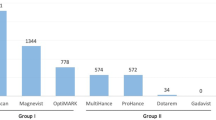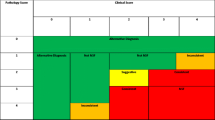Abstract
Purpose
To assess the risk of nephrogenic systemic fibrosis (NSF) in patients with renal impairment undergoing gadoxetic acid-enhanced magnetic resonance imaging.
Methods
This retrospective study included patients who had an estimated glomerular filtration rate (eGFR) below 60 mL/min per 1.73 m2 or had undergone dialysis around the time of gadoxetic acid exposure from January 2010 to November 2019. All patients received at least one intravenous injection of gadoxetic acid at a fixed dose of 2.5 mmol. The primary endpoint was the development of NSF after exposure to gadoxetic acid based on Girardi’s clinicopathological scoring system.
Results
A total of 204 patients with renal impairment received 424 injections of gadoxetic acid, of which 131 and 54 had an eGFR of 30–59 and < 30 mL/min per 1.73 m2, respectively, and 19 had undergone hemodialysis. Eighty-two patients received multiple injections, with 23 receiving five or more injections. The dose of each exposure ranged from 0.02 to 0.07 mmol/kg and the cumulative doses ranged from 0.02 to 0.45 mmol/kg. Thirty-three patients had concomitant Child–Pugh class B or C cirrhosis. No NSF was detected during follow-up (median 20 months; range 6 days to 111 months). The upper bound of the 95% confidence interval for NSF risk was 2.2% and 1.1% per patient and examination, respectively.
Conclusion
No NSF was detected in this study. However, it is premature to ascertain the risk of NSF using gadoxetic acid in patients with renal impairment and further studies are warranted.

Similar content being viewed by others
References
Girardi M, Kay J, Elston DM, Leboit PE, Abu-Alfa A, Cowper SE (2011) Nephrogenic systemic fibrosis: clinicopathological definition and workup recommendations. J Am Acad Dermatol 65 (6):1095-1106. https://doi.org/10.1016/j.jaad.2010.08.041
Cowper SE, Robin HS, Steinberg SM, Su LD, Gupta S, LeBoit PE (2000) Scleromyxoedema-like cutaneous diseases in renal-dialysis patients. Lancet 356 (9234):1000-1001. https://doi.org/10.1016/s0140-6736(00)02694-5
Grobner T (2006) Gadolinium – a specific trigger for the development of nephrogenic fibrosing dermopathy and nephrogenic systemic fibrosis? Nephrol Dial Transplant 21 (4):1104-1108. https://doi.org/10.1093/ndt/gfk062
Prince MR, Zhang HL, Roditi GH, Leiner T, Kucharczyk W (2009) Risk factors for NSF: a literature review. J Magn Reson Imaging 30 (6):1298-1308. https://doi.org/10.1002/jmri.21973
Reilly RF (2008) Risk for nephrogenic systemic fibrosis with gadoteridol (ProHance) in patients who are on long-term hemodialysis. Clin J Am Soc Nephrol 3 (3):747-751. https://doi.org/10.2215/cjn.05721207
Panda S, Bandyopadhyay D, Tarafder A (2006) Nephrogenic fibrosing dermopathy: a series in a non-Western population. J Am Acad Dermatol 54 (1):155-159. https://doi.org/10.1016/j.jaad.2005.10.007
Shabana WM, Cohan RH, Ellis JH, Hussain HK, Francis IR, Su LD, Mukherji SK, Swartz RD (2008) Nephrogenic systemic fibrosis: a report of 29 cases. AJR Am J Roentgenol 190 (3):736-741. https://doi.org/10.2214/ajr.07.3115
Rydahl C, Thomsen HS, Marckmann P (2008) High prevalence of nephrogenic systemic fibrosis in chronic renal failure patients exposed to gadodiamide, a gadolinium-containing magnetic resonance contrast agent. Invest Radiol 43 (2):141-144. https://doi.org/10.1097/rli.0b013e31815a3407
Schmitt-Willich H (2007) Stability of linear and macrocyclic gadolinium based contrast agents. Br J Radiol 80 (955):581-585. https://doi.org/10.1259/bjr/17326033
American College of Radiology, Committee on Drugs and Contrast Media (2018) ACR manual on contrast media. https://www.acr.org/-/media/ACR/Files/Clinical-Resources/Contrast_Media.pdf. Accessed 20 April 2020
European Society of Urogenital Radiology, Contrast Media Safety Committee (2018) ESUR Guidelines on Contrast Agents. http://www.esur.org/fileadmin/content/2019/ESUR_Guidelines_10.0_Final_Version.pdf. Accessed 20 April 2020
Woolen SA, Shankar PR, Gagnier JJ, MacEachern MP, Singer L, Davenport MS (2019) Risk of nephrogenic systemic fibrosis in patients with stage 4 or 5 chronic kidney disease receiving a group II gadolinium-based contrast agent: a systematic review and meta-analysis. JAMA Intern Med 180 (2):223-230. https://doi.org/10.1001/jamainternmed.2019.5284
Wang Y, Alkasab TK, Narin O, Nazarian RM, Kaewlai R, Kay J, Abujudeh HH (2011) Incidence of nephrogenic systemic fibrosis after adoption of restrictive gadolinium-based contrast agent guidelines. Radiology 260 (1):105-111. https://doi.org/10.1148/radiol.11102340
Attari H, Cao Y, Elmholdt TR, Zhao Y, Prince MR (2019) A systematic review of 639 patients with biopsy-confirmed nephrogenic systemic fibrosis. Radiology 292 (2):376-386. https://doi.org/10.1148/radiol.2019182916
Marks RM, Ryan A, Heba ER, Tang A, Wolfson TJ, Gamst AC, Sirlin CB, Bashir MR (2015) Diagnostic per-patient accuracy of an abbreviated hepatobiliary phase gadoxetic acid-enhanced MRI for hepatocellular carcinoma surveillance. AJR Am J Roentgenol 204 (3):527-535. https://doi.org/10.2214/ajr.14.12986
Kim HJ, Lee SS, Byun JH, Kim JC, Yu CS, Park SH, Kim AY, Ha HK (2015) Incremental value of liver MR imaging in patients with potentially curable colorectal hepatic metastasis detected at CT: a prospective comparison of diffusion-weighted imaging, gadoxetic acid-enhanced MR imaging, and a combination of both MR techniques. Radiology 274 (3):712-722. https://doi.org/10.1148/radiol.14140390
Grazioli L, Bondioni MP, Haradome H, Motosugi U, Tinti R, Frittoli B, Gambarini S, Donato F, Colagrande S (2012) Hepatocellular adenoma and focal nodular hyperplasia: value of gadoxetic acid-enhanced MR imaging in differential diagnosis. Radiology 262 (2):520-529. https://doi.org/10.1148/radiol.11101742
Gschwend S, Ebert W, Schultze-Mosgau M, Breuer J (2011) Pharmacokinetics and imaging properties of Gd-EOB-DTPA in patients with hepatic and renal impairment. Invest Radiol 46 (9):556-566. https://doi.org/10.1097/rli.0b013e31821a218a
Schieda N, van der Pol CB, Walker D, Tsampalieros AK, Maralani PJ, Woo S, Davenport MS (2020) Adverse events to the gadolinium-based contrast agent gadoxetic acid: systematic review and meta-analysis. Radiology 297 (3):565-572. https://doi.org/10.1148/radiol.2020200073
Lauenstein T, Ramirez-Garrido F, Kim YH, Rha SE, Ricke J, Phongkitkarun S, Boettcher J, Gupta RT, Korpraphong P, Tanomkiat W, Furtner J, Liu PS, Henry M, Endrikat J (2015) Nephrogenic systemic fibrosis risk after liver magnetic resonance imaging with gadoxetate disodium in patients with moderate to severe renal impairment: results of a prospective, open-label, multicenter study. Invest Radiol 50 (6):416-422. https://doi.org/10.1097/rli.0000000000000145
Alhadad A, Sterner G, Svensson A, Alhadad H, Leander P (2012) Incidence of nephrogenic systemic fibrosis at a large university hospital in Sweden. Scand J Urol Nephrol 46 (1):48-53. https://doi.org/10.3109/00365599.2011.621142
Song KD, Kim SH, Lee J, Kang KA, Kim J, Yoo H (2015) Half-dose gadoxetic acid-enhanced liver magnetic resonance imaging in patients at risk for nephrogenic systemic fibrosis. Eur J Radiol 84 (3):378-383. https://doi.org/10.1016/j.ejrad.2014.12.010
Starekova J, Bruce RJ, Sadowski EA, Reeder SB (2020) No cases of nephrogenic systemic fibrosis after administration of gadoxetic acid. Radiology 297 (3):556-562. https://doi.org/10.1148/radiol.2020200788
Stevens PE, Levin A, Kidney Disease: Improving Global Outcomes Chronic Kidney Disease Guideline Development Work Group Members (2013) Evaluation and management of chronic kidney disease: synopsis of the kidney disease: improving global outcomes 2012 clinical practice guideline. Ann Intern Med 158 (11):825-830. https://doi.org/10.7326/0003-4819-158-11-201306040-00007
Stevens LA, Coresh J, Feldman HI, Greene T, Lash JP, Nelson RG, Rahman M, Deysher AE, Zhang YL, Schmid CH, Levey AS (2007) Evaluation of the modification of diet in renal disease study equation in a large diverse population. J Am Soc Nephrol 18 (10):2749-2757. https://doi.org/10.1681/asn.2007020199
Pugh RN, Murray-Lyon IM, Dawson JL, Pietroni MC, Williams R (1973) Transection of the oesophagus for bleeding oesophageal varices. Br J Surg 60 (8):646-649. https://doi.org/10.1002/bjs.1800600817
Huh J, Kim SY, Yeh BM, Lee SS, Kim KW, Wu EH, Wang ZJ, Zhao LQ, Chang WC (2015) Troubleshooting arterial-phase MR images of gadoxetate disodium-enhanced liver. Korean J Radiol 16 (6):1207-1215. https://doi.org/10.3348/kjr.2015.16.6.1207
Agresti A, Coull BA (1998) Approximate is better than “exact” for interval estimation of binomial proportions. The American Statistician 52 (2):119-126. https://doi.org/10.1080/00031305.1998.10480550
Prince MR, Zhang H, Morris M, MacGregor JL, Grossman ME, Silberzweig J, DeLapaz RL, Lee HJ, Magro CM, Valeri AM (2008) Incidence of nephrogenic systemic fibrosis at two large medical centers. Radiology 248 (3):807-816. https://doi.org/10.1148/radiol.2483071863
Vogl TJ, Kummel S, Hammerstingl R, Schellenbeck M, Schumacher G, Balzer T, Schwarz W, Muller PK, Bechstein WO, Mack MG, Sollner O, Felix R (1996) Liver tumors: comparison of MR imaging with Gd-EOB-DTPA and Gd-DTPA. Radiology 200 (1):59-67. https://doi.org/10.1148/radiology.200.1.8657946
Bae KT (2003) Peak contrast enhancement in CT and MR angiography: when does it occur and why? Pharmacokinetic study in a porcine model. Radiology 227 (3):809-816. https://doi.org/10.1148/radiol.2273020102
Tirkes T, Mehta P, Aisen AM, Lall C, Akisik F (2015) Comparison of dynamic phase enhancement of hepatocellular carcinoma using gadoxetate disodium vs gadobenate dimeglumine. J Comput Assist Tomogr 39 (4):479-482. https://doi.org/10.1097/rct.0000000000000234
Othersen JB, Maize JC, Woolson RF, Budisavljevic MN (2007) Nephrogenic systemic fibrosis after exposure to gadolinium in patients with renal failure. Nephrol Dial Transplant 22 (11):3179-3185. https://doi.org/10.1093/ndt/gfm584
Hamm B, Staks T, Muhler A, Bollow M, Taupitz M, Frenzel T, Wolf KJ, Weinmann HJ, Lange L (1995) Phase I clinical evaluation of Gd-EOB-DTPA as a hepatobiliary MR contrast agent: safety, pharmacokinetics, and MR imaging. Radiology 195 (3):785-792. https://doi.org/10.1148/radiology.195.3.7754011
Muhler A, Heinzelmann I, Weinmann HJ (1994) Elimination of gadolinium-ethoxybenzyl-DTPA in a rat model of severely impaired liver and kidney excretory function. An experimental study in rats. Invest Radiol 29 (2):213-216. https://doi.org/10.1097/00004424-199402000-00017
Perez-Rodriguez J, Lai S, Ehst BD, Fine DM, Bluemke DA (2009) Nephrogenic systemic fibrosis: incidence, associations, and effect of risk factor assessment—report of 33 cases. Radiology 250 (2):371-377. https://doi.org/10.1148/radiol.2502080498
Author information
Authors and Affiliations
Corresponding author
Ethics declarations
Conflict of interest
The authors declare that there is no conflict of interest.
Ethical approval
This article contains studies with human participants and the institutional review board approved the protocol of this study.
Additional information
Publisher's Note
Springer Nature remains neutral with regard to jurisdictional claims in published maps and institutional affiliations.
Rights and permissions
About this article
Cite this article
Tseng, TY., Tseng, JH., Huang, BS. et al. Risk of nephrogenic systemic fibrosis in patients with impaired renal function undergoing fixed-dose gadoxetic acid-enhanced magnetic resonance imaging. Abdom Radiol 46, 3995–4001 (2021). https://doi.org/10.1007/s00261-021-03045-4
Received:
Revised:
Accepted:
Published:
Issue Date:
DOI: https://doi.org/10.1007/s00261-021-03045-4




